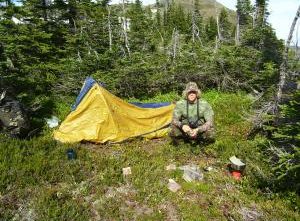Tents and Bivy Sacs
Tents and Bivy Sacs
Whether you are out in the forest or up on the mountain, the right type of tent or bivy sac can make the difference between a successful, comfortable trip or a nightmare expedition at your hunting camp site.
Tents are available in different types and materials. There are staked designs where you need to drive stakes into the ground to stabilize it. The other type is the free-standing type, which is for all terrains and you can still stake it. These types of tents are heavier than the staked designs but newer designs with locking clips and full length sleeves are faster to set up. Depending on the weather conditions where you plan to camp, you can decide on the following 2 types of tents:
1) 3 Season Tents: As the name denotes, these tents are good for moderate weathers such as summer, rains and spring, but are not suitable for winter. These are light in weight and made usually with light nylon material.
2) 4 Season Tents: These tents take care of the 4th extreme weather, which is snow. They are built sturdier and are hence heavier than their 3 Season counterparts. Your ideal 4 season tent should contain double vestibules for cooking and storing camping gear, good ventilation, bathtub floor i.e. fewer seams on the floor, and additional tie downs to make it wind resistant. These tents also come in 1 wall and 2 wall designs, but the 2-wall design is better since it dries out moisture quickly and the outer wall offers better protection from the cold. 1-walled tents are lighter and costlier than 2-walled tents and are more suitable only for high altitude climbs. All in all, the 2-wall tent makes more sense. So, the main features to check in a good practical tent are that it should be waterproof with a bathtub floor, a good zip, and double vestibules for easy access.
If you are used to sleeping alone, then you could also consider a bivy sack or bivy sac. This is a cross between a tent and a sleeping bag and is very compact while folding and carrying. If you do not want to lug around a tent and set it up on every trip, then a bivy sac can solve your problem. A bivy sac is made up of nylon, which is coated on the underside with urethane, thereby making it waterproof. The upper nylon is made up of ripstop, which is coated in multiple layers of Tegraltex or Gore Tex, which makes it waterproof and breathable. A bivy sac keeps you dry and warm. During the monsoons, it becomes difficult to keep a dry face. Hence, the bivy shelter has an expanded headspace and a complete enclosure, which shields you from the weather and irritating insects. 2 walled mini tents have also entered the market, which offer a little more room than a bivy sac. Even though the weight is more than a regular bivy sac, it is still preferred over the bivy sac.
Choosing between a tent and a bivy sac depends on your camping conditions. If weight is a very important factor and if the climate at your campsite is moderate, then a bivy sac or a bivy shelter is all right. However, if you normally camp in places where there is excess rain, snow or cold, then a 2-walled tent will definitely provide you better protection. A bivy also needs proper circulation through the nylon material for you to remain warm and dry inside. A 2-walled tent on the other hand removes condensation far more efficiently. Some of the brands available in the market are Sierra Designs, Kelty Clark Tent, Outdoor Research, Moonstone, etc. You can visit camping stores or even check out the Internet for their pricing structures and other features.
So, whichever dwelling you choose to sleep through the night, buy it only after considering all the factors regarding the place and weather at your campsite.



